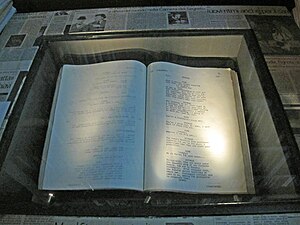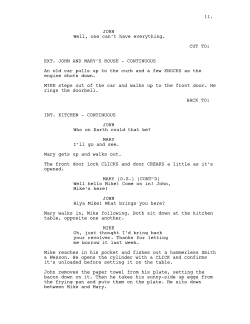Screenplay
Da wikiort.
A screenplay or script is a written work by screenwriters for a film, video game, or television program. These screenplays can be original works or adaptations from existing pieces of writing. In them, the movement, actions, expression, and dialogues of the characters are also narrated. A play for television is also known as a teleplay.
Indice
Format and style
The format is structured in a way that one page usually equates to one minute of screen time. In a "shooting script", each scene is numbered, and technical direction may be given. In a "spec" or a "draft" in various stages of development, the scenes are not numbered, and technical direction is at a minimum. The standard font for a screenplay is 12 point, 10 pitch Courier Typeface.[1]
The major components are action and dialogue. The "action" is written in the present tense. The "dialogue" are the lines the characters speak. Unique to the screenplay (as opposed to a stage play) is the use of slug lines.
A slug line, also called a master scene heading, occurs at the start of every scene, and is usually made up of three parts. Part one states whether the scene is set inside (interior/INT.) outside (exterior/EXT.), or both. Part two states location of the scene. Part three, separated from Part two by a hyphen, refers to the time of the scene. Each slug line begins a new scene. In a shooting script, the slug lines are numbered consecutively. These scene numbers serve as mile-post markers in a script. This allows any part of the script to be referred to by scene number.
The format consists of three aspects
- The interplay between typeface/font, line spacing and type area, from which the concept of one page of text per one minute of screen time is derived, but is in practice only used as a ball park estimation, and often bears little resemblance to the running time of the final movie.[2] In the United States letter size paper and Courier 12 point are mandatory; Europe uniformly uses A4 as the standard paper size format using 12 point 10 pitch Courier as per the US.
- The tab settings of the scene elements (dialogue, scenes headings, transitions, parentheticals, etc.), which constitute the screenplay's layout.
- The dialogue must be centered and the names must be capitalized. A script usually begins with "FADE IN:", followed by the first scene description. It might get more specific, e.g. "FADE IN ON AN ECU of Ricky as he explains the divorce to Bob." A script will usually end with "FADE TO BLACK", though there are variables, like "CUT TO BLACK" for abrupt endings.
The style consists of a grammar that is specific to screenplays. This grammar also consists of two aspects:
- A prose that is manifestation-oriented, i.e. focuses largely on what is audible and what is visible on screen. This prose may only supply interpretations and explanation (deviate from the manifestation-oriented prose) if clarity would otherwise be adversely affected.
- Codified notation of certain technical or dramatic elements, such as scene transitions, changes in narrative perspective, sound effects, emphasis of dramatically relevant objects and characters speaking from outside a scene.
Physical format
American screenplays are printed single-sided on three-hole-punched paper using the standard American letter size (8.5 x 11 inch). They are then held together with two brass brads in the top and bottom hole. The middle hole is left empty as it would otherwise make it harder to quickly read the script.
In the United Kingdom, double-hole-punched A4 paper is normally used, which is slightly taller and narrower than US letter size. Some UK writers format the scripts for use in the US letter size, especially when their scripts are to be read by American producers, since the pages would otherwise be cropped when printed on US paper. Because each country's standard paper size is difficult to obtain in the other country, British writers often send an electronic copy to American producers, or crop the A4 size to US letter.
A British script may be bound by a single brad at the top left hand side of the page, making flicking through the paper easier during script meetings. Screenplays are usually bound with a light card stock cover and back page, often showing the logo of the production company or agency submitting the script, covers are there to protect the script during handling which can reduce the strength of the paper. This is especially important if the script is likely to pass through the hands of several people or through the post.
Increasingly, reading copies of screenplays (that is, those distributed by producers and agencies in the hope of attracting finance or talent) are distributed printed on both sides of the paper (often professionally bound) to reduce paper waste. Occasionally they are reduced to half-size to make a small book which is convenient to read or put in a pocket; this is generally for use by the director or production crew during shooting.
Although most writing contracts continue to stipulate physical delivery of three or more copies of a finished script, it is common for scripts to be delivered electronically via email. Although most production companies can handle scripts in most formats, it is better practice to supply scripts as a PDF file where possible. This is because it gives the writer final control over the layout of the script, which may otherwise vary depending on what fonts and/or paper size the recipient uses to print the script. The formatting software programs listed at the bottom of this article produce industry standard formatted screenplays in PDF.
Screenplay formats
Screenplays and teleplays use a set of standardizations, beginning with proper formatting. These rules are in part to serve the practical purpose of making scripts uniformly readable "blueprints" of movies, and also to serve as a way of distinguishing a professional from an amateur. It is very important that the correct format be used, as otherwise the script is likely to be disregarded very quickly. There are practical reasons for this. An incorrectly formatted script can be very difficult for actors to read from, when testing the script out. If you are unsure exactly what is required, then at least be consistent, and keep things as simple as possible.
Feature film

Motion picture screenplays intended for submission to mainstream studios, whether in the US or elsewhere in the world, are expected to conform to a standard typographical style known widely as studio format which stipulates how elements of the screenplay such as scene headings, action, transitions, dialog, character names, shots and parenthetical matter should be presented on the page, as well as the font size and line spacing.
One reason for this is that, when rendered in studio format, most screenplays will transfer onto the screen at the rate of approximately one page per minute. This rule of thumb is widely contested — a page of dialogue usually occupies less screen time than a page of action, for example, and it depends enormously on the literary style of the writer — and yet it continues to hold sway in modern Hollywood.
There is no single standard for studio format. Some studios have definitions of the required format written into the rubric of their writer's contract. The Nicholl Fellowship, a screenwriting competition run under the auspices of the Academy of Motion Picture Arts and Sciences, has a guide to screenplay format.[3] A more detailed reference is The Complete Guide to Standard Script Formats.[4]
Screenplays are usually 90-120 pages long, comedies and children's films usually shorter.
Screenplays are almost always written using a monospaced font, often a variant of Courier or Courier New, both mostly used as 12 pt font. This is preferred due to its clarity.
Spec screenplay
A "spec script" or speculative screenplay is a script written to be sold on the open market with no upfront payment, or promise of payment. The content is usually invented solely by the screenwriter, though spec screenplays can also be based on established works, or real people and events.[5]
Television
For American TV shows, the format rules for hour-long dramas, like CSI, and single-camera sitcoms, like Scrubs, are essentially the same as for motion pictures. The main difference is that TV scripts have act breaks. Multi-camera sitcoms like I Love Lucy use a different, specialized format that derives from radio and the stage play. In this format, dialogue is double-spaced, action lines are capitalized, and scene headings, character entrances and exits, and sound effects are capitalized and underlined.
Drama series and sitcoms are no longer the only formats that require the skills of a writer. With reality-based programming crossing genres to create various hybrid programs, many of the so-called "reality" programs are in a large part scripted in format. That is, the overall skeleton of the show and its episodes are written to dictate the content and direction of the program. The Writers Guild of America has identified this as a legitimate writer's medium, so much so that they have lobbied to impose jurisdiction over writers and producers who "format" reality-based productions. Creating reality show formats involves storytelling structure similar to screenwriting, but much more condensed and boiled down to specific plot points or actions related to the overall concept and story.
Documentaries
The script format for documentaries and audio-visual presentations which consist largely of voice-over matched to still or moving pictures is different again and uses a two-column format which can be particularly difficult to achieve in standard word processors, at least when it comes to editing or rewriting. Many script-editing software programs include templates for documentary formats.
Screenwriting software
Template:Main Various screenwriting software packages are available to help screenwriters adhere to the strict formatting conventions. Detailed computer programs are designed specifically to format screenplays, teleplays, and stage plays. Such packages include BPC-Screenplay, Celtx, Fade In, Final Draft, FiveSprockets, Montage, Movie Magic Screenwriter, Movie Outline 3.0, and Scrivener, Movie Draft SE and Zhura. Software is also available as web applications, accessible from any computer, and on mobile devices, such as Fade In Mobile and Scripts Pro.
The first screenwriting software was SmartKey, a macro program that sent strings of commands to existing word processing programs, such as WordStar, WordPerfect and Microsoft Word. SmartKey was popular with screen writers from 1982–1987, after which word processing programs had their own macro features.
See also
- Act structure
- Closet screenplay
- Filmmaking
- Scriptment
- Screenplay slug line
- Screenwriter's salary
- Screenwriting
- Screenwriting software
- Storyboard
- List of film-related topics
- List of screenwriting software
- Dreams on Spec
- Guide to Literary Agents
- Writer's Digest
References
Further reading
- Template:Cite book - Paperback
- Template:Cite book - Paperback
- Template:Cite book - Paperback
- Template:Cite book - Paperback
- Luca Bandirali and Enrico Terrone, Il sistema sceneggiatura. Scrivere e descrivere i film, Lindau, Torino, 2009, ISBN 978-88-7180-831-4.
- Riley, C. (2005) The Hollywood Standard: the complete and authoritative guide to script format and style. Michael Weise Productions. Sheridan Press. ISBN 0-941188-94-9.
External links
Template:Library resources box
- Writing section from the MovieMakingManual (MMM) Wikibook, especially on formatting.
- American Screenwriters Association
- Template:Dmoz
Template:Filmmaking paper trail Template:Fiction writing
Template:Authority control- ↑ JohnAugust.com "Hollywood Standard Formatting"
- ↑ JohnAugust.com "How accurate is the page-per-minute rule?
- ↑ Guide to screenplay format from the website of the Academy of Motion Picture Arts and Sciences
- ↑ The Complete Guide to Standard Script Formats (2002) Cole and Haag, SCB Distributors, ISBN 0-929583-00-0.
- ↑ Template:Cite web
